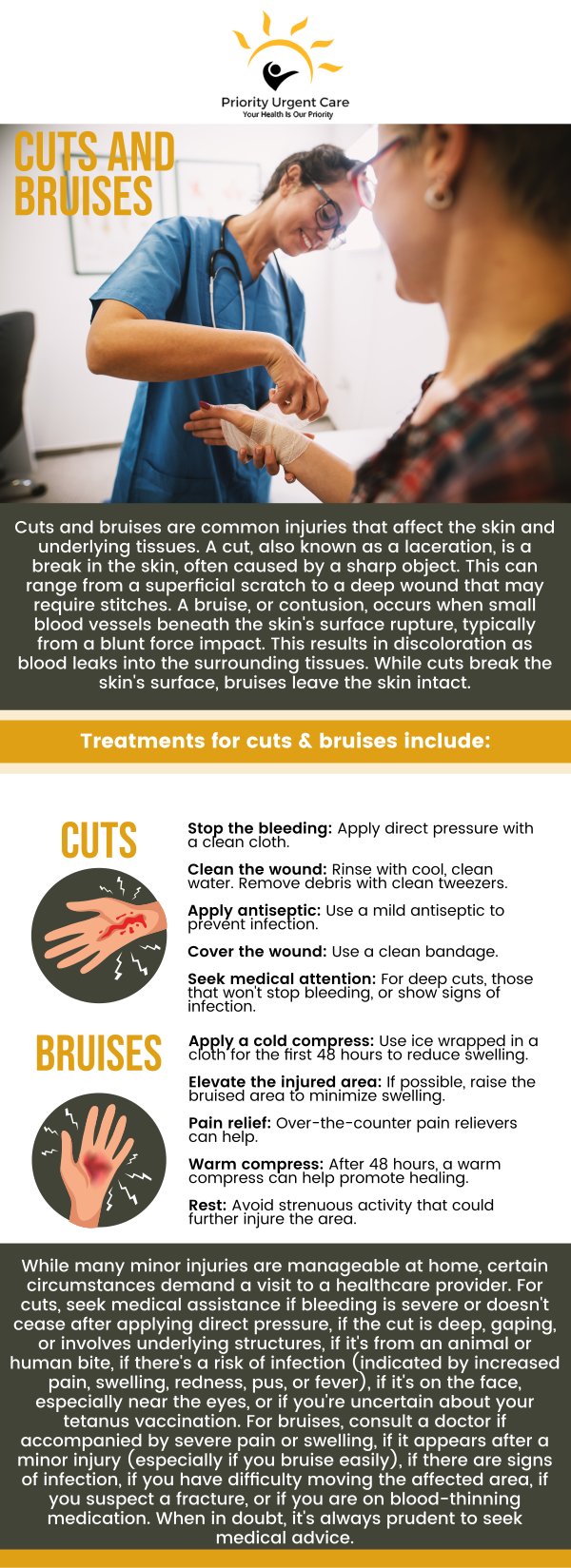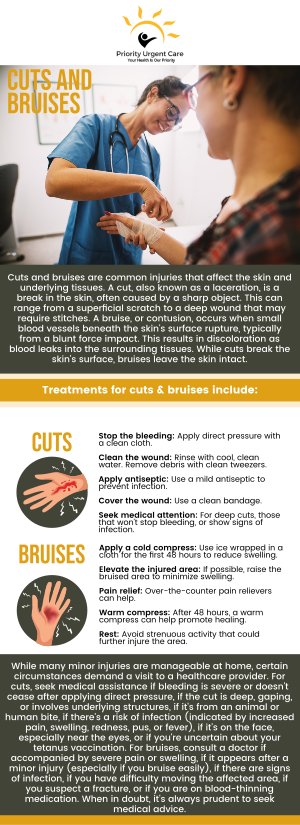Urgent Care for Bruises and Cuts Treatment Q&A
If you have a cut or bruise that you are concerned about, visit Priority Urgent Care & Walk-In Clinic today! Our doctors, medical staff, and facility are equipped to handle all your medical needs. We serve children, adults, and seniors seven days a week. Appointments are preferred to secure a time slot, but walk-ins are always welcome. For more information, contact us today or book an appointment online. We have convenient locations to serve you in Cromwell CT, East Haven CT, Ellington CT, Newington, CT, Oxford, CT, Unionville CT and Wallingford, CT.




Table of Contents:
What is the difference between bruises and cuts?
How do you know if a bruise or cut is serious?
When should you seek help for bruises and cuts?
How long do bruises and cuts take to heal?
With the skin being the body’s largest, and most exposed organ, it is not surprising that it is susceptible to common, everyday injuries such as bruises and cuts. Some of the most common workplace injuries are slipping and tripping, falling from a height, and being hit by falling objects, all of which are likely to result in a bruise and/or a cut. When you factor in everyday occurrences such as accidents at home, at school, or on the road, knowing what to do with a bruise or cut is important as you may have to decide between treating it at home or seeking medical attention.
The most obvious difference between bruises and cuts is that one pierces the skin and the other one doesn’t. A bruise is caused when small blood vessels break under the skin causing discoloration, often as a result of a direct blow, and a cut is when something sharp, such as a knife or glass, pierces the skin. Slight bruising around a cut or puncture wound is normal, but if it begins to appear within 30 minutes of an injury it could indicate a large amount of bleeding beneath the skin and damage to deeper tissues and prompt medical treatment should be sought.
As we know, bruises and cuts can range in severity, and most can be treated at home or during a visit to the nearest Urgent Care. Sometimes, however, they can be symptomatic of a more serious injury and medical attention should be sought if the following apply:
• The injury initially seemed minor, but there is still pain after three days
• A lump develops over the bruise
• Bruising seems to appear for no reason
• Blood is present in the urine or stools
As stated above, many bruises and cuts can be effectively treated at home, but there are some situations that necessitate medical attention. In the case of bruises, these include:
• Increased bruising while taking blood thinners
• Pain and swelling around the bruise
• Bruising that appears after a fall or a hard blow
• Bruising that occurs along with a possible broken bone
• Bruising that appears for no reason
• Bruising that hasn’t healed after four weeks
• Painful bruising under the fingernails or toenails
• Bruising that is accompanied by bleeding from gums, mouth, or nose
• Bruising that is accompanied by blood in the urine or stools, or in the eyes
• Unexplained, recurring, bruising that appears in a pattern
• Bruises that are not painful
• Bruises that re-emerge in the same area without having sustained an injury
• Any black bruises on the legs which can indicate Deep Vein Thrombosis, or DVT. This is the development of a blood clot in a deep vein and can be life-threatening.
With cuts, seek medical advice if:
• It is deep and may need stitches
• It won’t stop bleeding
• It is believed to have become infected
• It is healing too slowly, regardless of its size
Naturally, the length of time a bruise or cut takes to heal will depend on its severity. A bruise is generally gone in around two weeks, any longer than that and it may be a sign of an underlying condition that requires medical advice. The typical healing time for a bruise is marked by its changes in color:
• Red. A red mark immediately follows the trauma and becomes more apparent as blood begins to leak.
• Black, blue, or purple. The bruise will turn black, blue, or dark purple within 24 hours or so as more blood pools in the area.
• Yellow or green. Within 2 to 3 days there is a greater concentration of yellow or green as the body starts to reabsorb the blood.
• Light brown. By days 10 to 14, the bruise will fade to a light brown color and will disappear completely.
Providing there are no complications, such as infection, a minor, or superficial, cut usually heals within 3 to 7 days. A larger, deeper wound will take longer – typically a week or two – depending on the severity.
For an appointment with us at Priority Urgent Care or more information about treatment, we welcome you to contact us, schedule an appointment through our website. We serve patients from Cromwell CT, East Haven CT, Ellington CT, Newington, CT, Oxford, CT, Unionville CT, Wallingford, CT and BEYOND!

Additional Services You May Need
▸ Urgent Care
▸ DOT Physicals
▸ Worker’s Injury Treatment
▸ Drug Testing
▸ Physical Exams
▸ School/Sports Physicals
▸ Sports Injury Treatment
▸ X-Ray Services
▸ Pediatric Urgent Care
▸ Poison Ivy
▸ STD Testing
▸ Immunizations & Vaccinations
▸ Lab Testing
▸ Pre-Employment Physical
▸ Employer Services


